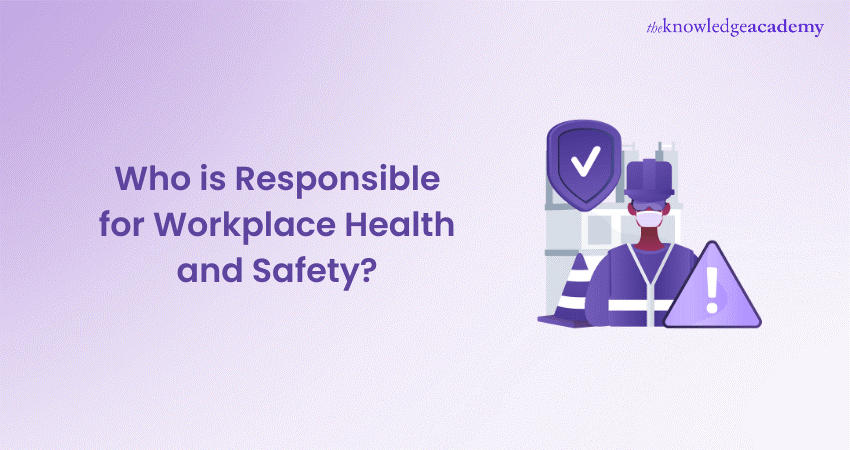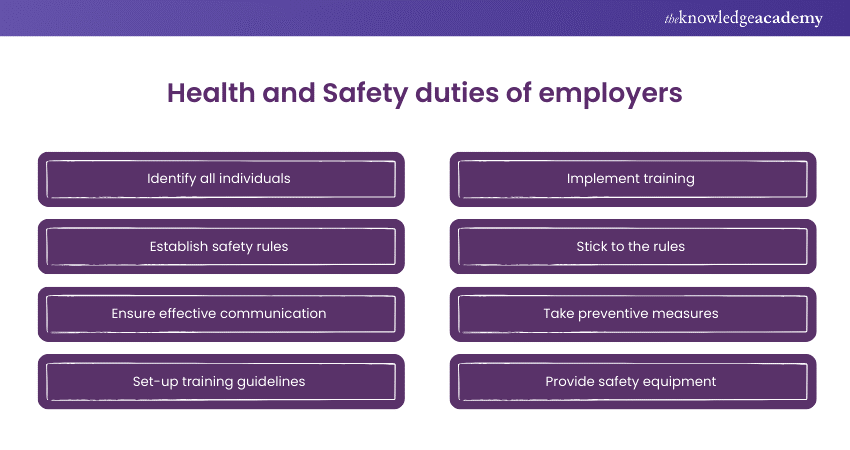We may not have the course you’re looking for. If you enquire or give us a call on +33 805638382 and speak to our training experts, we may still be able to help with your training requirements.
We ensure quality, budget-alignment, and timely delivery by our expert instructors.

If you are joining or will join an organisation soon, you should know Who is Responsible for Workplace Health and Safety. It is a critical aspect of any organisation, requiring stakeholders' active involvement and cooperation to ensure a safe and Healthy working environment. The primary responsibility lies with employers, who must implement comprehensive Safety measures, provide training, and maintain a hazard-free workplace.
Additionally, government agencies play a crucial role by establishing Health and Safety standards, conducting inspections, and enforcing regulations. These entities create a framework to minimise risks and protect workers from harm. Read this blog to learn Who is Responsible for Workplace Health and Safety and how it benefits everyone involved.
Table of Contents
1) Who is accountable for Workplace Health and Safety?
2) Employers’ Safety Duties at Work
a) Identify who needs to be kept safe
b) Make sure everyone follows safety rules
c) Plan for Health and Safety for Health and Safety
d) Communicate Health and Safety information
e) Set up Health and Safety training
f) Check for possible dangers
g) Follow the safety plan
h) Teach the staff how to stay safe and Healthy
i) Give lessons and provide first-aid kits
j) Stick to the safety rules
k) Take action before problems happen
l) Provide Safety equipment and PPE
3) Conclusion
Who is accountable for Workplace Health and Safety?
Workplace Health and Safety is a responsibility that falls on various levels of an organisation and to the regulators.
First, employers are most accountable. They are responsible for ensuring safe working conditions, managing risks associated with safety, developing safety standards and procedures, and providing necessary protection to staff.
Employers must also comply with the national and local safety standards and regulations. They also must ensure that the workplace is safe. It is also their responsibility to follow the Safety Regulations and Rules laid down by their employers, to use their safety equipment appropriately and to inform the management or supervisors of any potential or actual hazards at the workplace.
Health and Safety are officially regulated by government agencies and related regulatory bodies. These bodies are responsible for conducting inspections and fining organisations that fail to meet the standards set. Performing Nebosh Risk assessment will ensure workplae safety. They also offer information and education that explains employers' and employees' rights and obligations.
For instance, contractors and suppliers are also partly responsible because their actions can affect workplace safety. The final point is that workplace safety cannot be guaranteed without the stakeholders' active involvement.
Employers’ Safety Duties at Work
Employers play a pivotal role in maintaining Workplace Health and Safety, encompassing various responsibilities to prevent accidents, injuries, and illnesses. These responsibilities are moral and ethical obligations and legal requirements in many jurisdictions. Here, we will discuss some of the specific duties employers must fulfil to uphold Workplace Health and Safety:

1) Identify who needs to be kept safe
An employer's first responsibility is to establish potential stakeholders in the workplace. This encompasses employees, contractors, visitors, and sometimes even the public. Knowing each group's unique characteristics and risks is crucial in developing an effective Safety plan.
2) Make sure everyone follows safety rules
It is the employer's responsibility to stipulate and enforce safety guidelines. This includes fostering a culture of safety where rules are upheld and adhered to. Penalties for non-compliance should be reasonable but strict and should be used to stress the significance of these rules.
3) Plan for Health and Safety
Health and Safety policy is the core of a safe working environment. It should also explain how risks will be managed, such as identifying potential hazards, risk assessment, and risk minimisation. It should be dynamic and change over time to accommodate workplace or industry standards changes.
4) Communicate Health and Safety information
Effective communication is critical. Employers are responsible for arming all workers with knowledge of their rights and responsibilities concerning Health and Safety. This includes possible risks, how to protect them, and what to do in an emergency.
5) Set up Health and Safety training
Training employees in Health and Safety practices is vital. This training must be tailored to the specific needs of the job and workplace and must be regularly updated and repeated to ensure long-term retention and relevance.
Do you want to learn how to analyse and evaluate workplace risks? Then register now for our Health and Safety in The Workplace Training!
6) Check for possible dangers
Creating systems to ensure that the workplace is free of potential hazards is a good preventative measure that can help reduce accidents. Employers need to plan these inspections at regular intervals, and they should be accompanied by a record of the results and remedial action taken against the defects found.
7) Follow the safety plan
If the goal is to be achieved, it is important to create and implement safety plans. Employers need to put in place mechanisms that will make it possible to achieve the objectives, strategies, and measures provided in the plan. This includes continuous evaluation to determine whether the objectives set have been achieved effectively and to implement any changes that might be necessary.
8) Teach the staff how to stay safe and Healthy
Beyond the technical training, the employer should create an environment where safety, health, and the prevention of discrimination in the workplace are intrinsic to everyday activities. This can include casual conversations, safety talks, and promoting open communication so workers can express their concerns about workplace safety and fair treatment.
9) Give lessons and provide first-aid kits
It is vital to provide first-aid training and easy access to first-aid kits. All employers must train their employees so that they have sufficient knowledge about first-aid decision-making and the availability of first-aid kits in the workplace.
10) Stick to the safety rules
Ensuring that workplace safety principles are consistent and followed is also essential. Employers have the responsibility of standing out and displaying commitment to actualising Health and Safety.
11) Take action before problems happen
Risk Assessment, as part of a proactive approach to Health and Safety, identifies potential hazards and takes corrective action to eliminate or minimise their potential occurrence. This involves being prepared for a workplace, the nature of its operations, and recent developments in industrial safety practices.
12) Provide safety equipment and PPE
Employees must be given the right Safety and protective tools. This equipment must be able to carry out the assigned functions without any hitches, and the employees must undergo the right training for the use of the machinery and equipment.
Do you want to learn more about how to build a proactive Health and Safety workplace culture? Sign up now for our Health & Safety in the Workplace Course!
Conclusion
We hope you understood Who is Responsible for Workplace Health and Safety from this blog. This blog also discussed that employers have a comprehensive set of duties designed to ensure the Health and Safety of everyone in the workplace. As part of this, understanding Environmental Health and Safety Interview Questions can be a key factor in ensuring that candidates are equipped with the knowledge and skills to contribute to a safe work environment. These responsibilities are interconnected, each crucial in fostering a safe working environment.
Learn how to create a framework that promotes a Healthy Working Environment with our Healthy Working Environment Training!
Frequently Asked Questions
Who is Responsible for Workplace Health and Safety

Yes, employees can refuse work if they believe it poses a significant danger to their Health or Safety. Employers must address these concerns promptly and ensure no punitive actions are taken against employees exercising this right.
Are small businesses exempt from Workplace Health and Safety laws?

No, small businesses are not exempt from Workplace Health and Safety laws. While the specific requirements may vary depending on the jurisdiction and industry, all businesses must ensure a safe working environment, regardless of size.
What are the other resources and offers provided by The Knowledge Academy?

The Knowledge Academy takes global learning to new heights, offering over 3,000 online courses across 490+ locations in 190+ countries. This expansive reach ensures accessibility and convenience for learners worldwide.
Alongside our diverse Online Course Catalogue, encompassing 19 major categories, we go the extra mile by providing a plethora of free educational Online Resources like News updates, Blogs, videos, webinars, and interview questions. Tailoring learning experiences further, professionals can maximise value with customisable Course Bundles of TKA.
What is Knowledge Pass, and how does it work?

The Knowledge Academy’s Knowledge Pass, a prepaid voucher, adds another layer of flexibility, allowing course bookings over a 12-month period. Join us on a journey where education knows no bounds.
What are related courses and blogs provided by The Knowledge Academy?

The Knowledge Academy offers various Health & Safety in the Workplace courses, including Health and Safety in The Workplace Training, Manual Handling at Work Training, and First Aid at Work Course. These courses cater to different skill levels, providing comprehensive insights into Importance of Health and Safety.
Our Health and Safety blogs covers a range of topics related to Health and Safety in The Workplace, offering valuable resources, best practices, and industry insights. Whether you are a beginner or looking to advance your skills in Health and Safety in The Workplace, The Knowledge Academy's diverse courses and informative blogs have you covered.
Upcoming Health & Safety Resources Batches & Dates
Date
 Health and Safety in the Workplace Training
Health and Safety in the Workplace Training
Fri 4th Apr 2025
Fri 27th Jun 2025
Fri 29th Aug 2025
Fri 24th Oct 2025
Fri 5th Dec 2025






 Top Rated Course
Top Rated Course



 If you wish to make any changes to your course, please
If you wish to make any changes to your course, please


